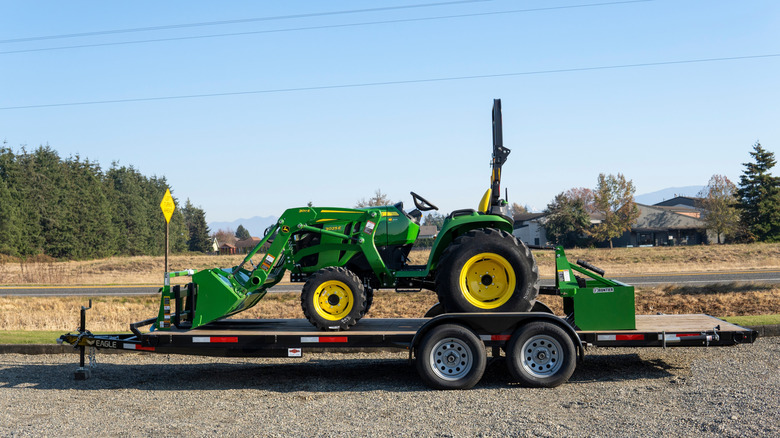How To Restore A Gravel Driveway With A Heavy Duty Tool
One of the biggest draws of installing a gravel driveway is the ease of maintenance. While they may take some more routine care than concrete options, most major issues can be avoided with a touch of effort. This is especially simple if you're working with a smaller space or you're committed to keeping up with it — for instance, if you rake it regularly. Unfortunately, however, issues can still arise.
If you have a large area that you need to smooth out (or you're dealing with a more extreme case of pitting and potholes), it could be helpful to bring in the big guns. Box scrapers are built to be attached to the back of a tractor, and their design is very simple. Essentially, they're a three-sided box with scarifiers, or blades/teeth, along the bottom. As you drive along, material on the ground gets broken up, swept up into the box, and released into an even layer. These attachments can be used to backfill large areas with dirt or to grade soil, but they're also a great choice to help even out a large gravel driveway.
How to use a box scraper to smooth out your driveway
The first step in smoothing out your driveway is, of course, getting your equipment in place. You'll need to attach your box scraper to the back of a tractor, lock everything down, and lower the scarifiers to your desired level. On this first pass, you'll want your scarifiers to sit low enough that they can reach the bottom of the potholes but high enough that they don't disrupt the foundation of the driveway. Go over the entire driveway on this setting, weaving along the surface, and repeat this process a few times. On each pass, change up your pattern slightly to make sure you're not creating grooves in the same spots. After about three or four passes, you should be left with a well-mixed layer of gravel.
One the surface is broken up, it's time to bring in your additional material. Make sure to choose one of the types of gravel that are best for driveways. Load up your bucket with crushed rock, then move along the driveway, dumping it as you go. Once everything is mostly covered, you can get to work on smoothing out the surface. Raise up the scarifiers on your box scraper so they sit above the surface, and lower the scraper itself to the ground. As you drive along, gravel will collect in the box and be released more evenly. After a few passes, making sure to change up your pattern, the driveway should look like new.
Where to get a box scraper
This project will obviously cost less if you already have a tractor, but, understandably, not everyone has easy access to heavy equipment. Thankfully, you can rent both a tractor and a box scraper if you're not planning to invest in one. Prices will vary based on the supplier, the amount of time you need the machine, and where you live, but Home Depot may be your best bet if you need a tool for the day. This popular home improvement store will rent you a tractor with a box scraper attachment for $329 a day. If you want to shop around, you can also check out local rental businesses to see who has the best price available.
For this project, you should also consider the cost of gravel. Gravel can cost between $20 and $150 per ton depending upon what type you choose, and you can calculate exactly how much you need to order based on the size of your driveway using an online calculator. Thankfully, gravel driveways are cost-effective, both in terms of the price of materials and the cost of installation, so this shouldn't be an extreme investment. For a simple refresh, you also won't need to order as much gravel as a full install, so you cut down the cost further by lowering the desired depth in your calculation.

